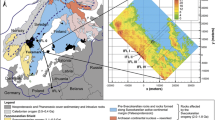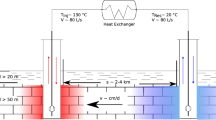Abstract
Underground land use can play a significant role in future concepts of energy and gas storage and requires an improved understanding of the parameters of potential storage formations (saline aquifers), for instance of porosity and permeability, and also of mineralogical and gas compositions. This study aims at providing data examples and calculating vertical spatial variations through variogram analyses of important North German geological reservoirs from Dogger, Rhaetian, Middle Buntsandstein, and Rotliegend (Sub)Groups and Formations, focusing on the western part of the North German Basin. Vertical correlation lengths of porosity and permeability data range between 0 and 30 m, while most results are calculated at approximately 2–4 m and do not show relevant differences among the evaluated formations. In the majority of the regarded formations, the Kozeny–Carman relationship between porosity and permeability is supported as long as low porosity and permeability values are excluded from the evaluation. Mineral percentages varied significantly among the evaluated sediments. Besides quartz, ankerite is the main compound in the Dogger Group, while feldspars and clay minerals were more frequent in the Rhaetian, Middle Buntsandstein, and Rotliegend sediments. Methane was the main gas compound in the reservoirs, followed by nitrogen, ethane, and carbon dioxide. This study serves as preparatory work to allow for the parameterization of geological models and a subsequent simulation of fluid transport to evaluate (long-term) safety and impacts of geothermal and gas storage projects.









Similar content being viewed by others
References
Aitchison J (2003) A concise guide to compositional data analysis. University of Glasgow, Glasgow
Ambrose WA, Lakshminarasimhan S, Holtz MH, Núñez-López V, Hovorka SD, Duncan I (2008) Geologic factors controlling CO2 storage capacity and permanence: case studies based on experience with heterogeneity in oil and gas reservoirs applied to CO2 storage. Environ Geol 54:1619–1633. doi:10.1007/s00254-007-0940-2
Bachu S, Gunter WD, Perkins EH (1994) Aquifer disposal of CO2: hydrodynamic and mineral trapping. Energy Convers Manag 35:269–279. doi:10.1016/0196-8904(94)90060-4
Barnes RJ (1991) Teachers aide: the variogram sill and the sample variance. Math Geol 23:673–678
Bauer S, Class H, Ebert M, Feeser V, Götze H, Holzheid A, Kolditz O, Rosenbaum S, Rabbel W, Schäfer D, Dahmke A (2012) Modeling, parameterization and evaluation of monitoring methods for CO2 storage in deep saline formations: the CO2-MoPa project. Environ Earth Sci 67:351–367. doi:10.1007/s12665-012-1707-y
Benisch K, Bauer S (2011) Investigation of large-scale pressure propagation and monitoring for CO2 injection using a real site model. In: ModelCARE 2011. Models—repositories of knowledge, vol. 355. IAHS Publication, Leipzig, pp 245–251 (2012), 18–22 Sep 2011
Beutler G (2005) Stratigraphie von Deutschland IV—Keuper. In: Deutsche Stratigraphische Kommission, Courier Forschungsinstitut Senckenberg, Frankfurt
Bonte M, Stuyfzand PJ, Hulsmann A, Van Beelen P (2011) Underground thermal energy storage: environmental risks and policy developments in the Netherlands and European Union. Ecol Soc 16(1)
Bourbie T, Zinszner B (1985) Hydraulic and acoustic properties as a function of porosity in Fontainebleau sandstone. J Geophys Res 90:11524–11532
Brandes J, Obst K (2011) Geological characterization of potential reservoir and barrier rock units in Mecklenburg-Western Pomerania. Schriftenreihe der Deutschen Gesellschaft für Geowissenschaften 74:61–81
Carman PC (1956) Flow of gases through porous media. Butterworths, London
Costa A (2006) Permeability–porosity relationship: a reexamination of the Kozeny–Carman equation based on a fractal pore-space geometry assumption. Geophys Res Lett 33:1–5
Esposito A, Benson SM (2012) Evaluation and development of options for remediation of CO2 leakage into groundwater aquifers from geologic carbon storage. Int J Greenh Gas Control 7:62–73. doi:10.1016/j.ijggc.2011.12.002
Flett M, Gurton R, Weir G (2007) Heterogeneous saline formations for carbon dioxide disposal: impact of varying heterogeneity on containment and trapping. J Petrol Sci Eng 57:106–118. doi:10.1016/j.petrol.2006.08.016
Franz M, Wolfgramm M (2008) Sedimentologie, Petrologie und Fazies geothermischer Reservoire des Norddeutschen Beckens am Beispiel der Exter-Formation (Oberer Keuper, Rhaetium) NE-Deutschlands. Z Geol Wiss 36:223–247
Fuchs S, Förster A (2010) Rock thermal conductivity of Mesozoic geothermal aquifers in the Northeast German Basin. Chem Erde 70:13–22
Geluk MC, Röhling HG (1997) High resolution sequence stratigraphy of the Lower Triassic “Buntsandstein” in the Netherlands and northwestern Germany. Geol Mijnbouw 76:227–246
Giese LB, Seibt A, Wiersberg T, Zimmer M, Erzinger J, Niedermann S, Pekdeger A (2002) Geochemistry of the formation fluids (Geochemie der Formationsfluide). In: Huenges E (ed) In-situ geothermal laboratory Groß Schönebeck: drilling, logging, hydraulic test, formation fluids and clay minerals. STR02/14 Geothermie Report 02-1. GeoForschungsZentrum Potsdam, Potsdam, pp 145–170
Götze J (1998) Geochemistry and provenance of the Altendorf feldspathic sandstone in the Middle Bunter of the Thuringian Basin (Germany). Chem Geol 150:43–61
Gringarten E, Deutsch CV (2001) Variogram interpretation and modeling. Math Geol 33:507–534
GTN (1997) Machbarkeitsstudie zum Einsatz geothermischer Ressourcen in der Wärmeversorgung von Hamburg. Geothermie Neubrandenburg GmbH, Neubrandenburg, p 39
Horn D (1964) Fazies, Diagenese und Ölmigration im Dogger-Beta-Hauptsandstein von Plön-Ost und Preetz (Ostholsteinischer Juratrog). Doctoral thesis (dissertation). Christian-Albrechts-Universität zu Kiel, Kiel
Hoth P, Seibt A, Kellner T (1997) Geowissenschaftliche Bewertungsgrundlagen zur Nutzung hydrothermaler Ressourcen in Norddeutschland. Geoforschungszentrum Potsdam, Potsdam
Hovorka SD, Doughty C, Benson SM, Pruess K, Knox PR (2004) The impact of geological heterogeneity on CO2 storage in brine formations: a case study from the Texas Gulf Coast. In: Baines SJ, Worden RH (eds) Geological storage of carbon dioxide. The Geological Society of London, London, pp 147–163
Kaufhold H, Hable R, Liebsch-Dörschner T, Thomsen C, Taugs R (2011) Distribution and properties of Mesozoic sandstones and barrier rocks in Schleswig–Holstein and Hamburg—basic information possible energetic utilisation of the deeper subsurface. Schriftenreihe der Deutschen Gesellschaft für Geowissenschaften 74:38–60
Kempka T, Kühn M, Class H, Frykman P, Kopp A, Nielsen CM, Probst P (2010) Modelling of CO2 arrival time at Ketzin—part I. Int J Greenh Gas Control 4:1007–1015. doi:10.1016/j.ijggc.2010.07.005
Knopf S, May F, Müller C, Gerling P (2010) Neuberechnung möglicher Kapazitäten zur CO2-Speicherung in tiefen Aquifer-Strukturen. Energiewirtschaftliche Tagesfragen 60:76–80
Kolditz O, Bauer S (2004) A process-oriented approach to computing multi-field problems in porous media. J Hydroinf 6:225–244
Kozeny J (1927) Über kapillare Leitung des Wassers im Boden. Sitzungsber. Akad. Wiss., Wien: 136(2a):271–306
Kushnir R, Ullmann A, Dayan A (2012) Thermodynamic and hydrodynamic response of compressed air energy storage reservoirs: a review. Rev Chem Eng 28:123–148. doi:10.1515/revce-2012-0006
Laier T, Nielsen BL (1989) Cementing halite in Triassic Bunter sandstone (Tønder, southwest Denmark) as a result of hyperfiltration of brines. Chem Geol 76:353–363. doi:10.1016/0009-2541(89)90103-4
Lee KS (2010) A review on concepts, applications, and models of aquifer thermal energy storage systems. Energies 3:1320–1334. doi:10.3390/en3061320
Lemieux JM (2011) Review: the potential impact of underground geological storage of carbon dioxide in deep saline aquifers on shallow groundwater resources. Hydrogeol J 19:757–778. doi:10.1007/s10040-011-0715-4
Lengler U, De Lucia M, Kühn M (2010) The impact of heterogeneity on the distribution of CO2: numerical simulation of CO2 storage at Ketzin. Int J Greenh Gas Control 4:1016–1025. doi:10.1016/j.ijggc.2010.07.004
Li X-Y, Logan BE (2001) Permeability of fractal aggregates. Water Res 35:3373–3380
Malakooti R, Azin R (2011) The optimization of underground gas storage in a partially depleted gas reservoir. Petrol Sci Technol 29:824–836. doi:10.1080/10916460903486742
Martens S, Kempka T, Liebscher A, Lüth S, Möller F, Myrttinen A, Norden B, Schmidt-Hattenberger C, Zimmer M, Kühn M, The Ketzin Group (2012) Europe’s longest-operating on-shore CO2 storage site at Ketzin, Germany: a progress report after three years of injection. Environ Earth Sci 67:323–334
McCann T (1998) Sandstone composition and provenance of the Rotliegend of the NE German Basin. Sed Geol 116:177–198. doi:10.1016/s0037-0738(97)00106-1
Mitiku AB, Bauer S (2013) Optimal use of a dome-shaped anticline structure for CO2 storage: a case study in the North German sedimentary basin. Environ Earth Sci. doi:10.1007/s12665-013-2580-z
Panfilov M (2010) Underground storage of hydrogen: in situ self-organisation and methane generation. Transp Porous Media 85:841–865. doi:10.1007/s11242-010-9595-7
Pawlowsky-Glahn V, Egozcue JJ, Tolosana-Delgado (2007) In: Lecture notes on compositional data analyses. University of Girona, Girona, p 87
Pfeiffer WT (2012) Einfluss von kleinskaligen geologischen Strukturen auf die Phasenausbreitung von CO2 in tiefen salinaren Formationen. MSc Thesis. Institute of Geosciences, Christian-Albrechts-University, Kiel
Plein E (1995) Stratigraphie von Deutschland: Norddeutsches Rotiegendbecken. Courier Forschungsinstitut Senckenberg, Frankfurt (p 193)
Pruess K (2004) The TOUGH codes—a family of simulation tools for multiphase flow and transport processes in permeable media. Vadose Zone J 3:738–746
Reimann C, Filzmoser P, Fabian K, Hron K, Birke M, Demetriades A, Dinelli E, Ladenberger A (2012) The concept of compositional data analysis in practice—total major element concentrations in agricultural and grazing land soils of Europe. Sci Total Environ 426:196–210
Reinhold K, Müller C (2011) Storage potential in the deeper subsurface—overview and results from the project storage catalogue of Germany. Schriftenreihe der Deutschen Gesellschaft für Geowissenschaften 74:9–27
Reinhold K, Müller C, Riesenberg C (2011) Informationssystem Speichergesteine für den Standort Deutschland—Synthese. Bundesanstalt für Geowissenschaften und Rohstoffe, Hannover (p 133)
Schäfer D, Schlenz B, Dahmke A (2004) Evaluation of exploration and monitoring methods for verification of natural attenuation using the virtual aquifer approach. Biodegrad J 15:453–465
Scheck M, Bayer U, Lewerenz B (2003) Salt movements in the Northeast German Basin and its relation to major post-permian tectonic phases—results from 3D structural modelling, backstripping and reflection seismic data. Tectonophysics 361:277–299
Schnaar G, Digiulio DC (2009) Computational modeling of the geologic sequestration of carbon dioxide. Vadose Zone J 8:389–403
Sedlacek R (2009) Untertage-Gasspeicherung in Deutschland. Erdöl Erdgas Kohle 125:412–425
Seibt A, Kellner T, Hoth P, Teil B (1997) Geowissenschaftliche Erfahrungen aus dem Betrieb geothermischer Heizzentralen Norddeutschlands; 8. Charakteristik der geothermischen Heizzentralen (GHZ) in Mecklenburg-Vorpommern. In: Schneider H, Huenges E (eds) Geowissenschaftliche Bewertungsgrundlagen zur Nutzung hydrogeothermaler Ressourcen in Norddeutschland. STR97/15 Geothermie report 97-1. GeoForschungsZentrum Potsdam, Potsdam, pp 135–150
van Genuchten MT (1980) A closed-form equation for predicting the hydraulic conductivity of unsaturated soils. Soil Sci Soc Am J 44:892–898. doi:10.2136/sssaj1980.03615995004400050002x
von Engelhart W (1960) Der Porenraum der Sedimente. Springer Verlag, Berlin/Göttingen/Heidelberg
Weibel R, Friis H (2004) Opaque minerals as keys for distinguishing oxidising and reducing diagenetic conditions in the Lower Triassic Bunter sandstone, North German Basin. Sed Geol 169:129–149
Wolfgramm M, Rauppach K, Seibt P (2008) Reservoir-geological characterization of Mesozoic sandstones in the North German Basin by petrophysical and petrographical data. Z Geol Wiss 36:249–265
Ziegler PA (1990) Geological atlas of western and central Europe. Shell Internationale Petroleum Maatschappij, UK
Acknowledgments
This study was funded by the German Federal Ministry of Education and Research (BMBF), EnBW Energie Baden-Württemberg AG, E.ON Energie AG, E.ON Gas Storage AG, RWE Dea AG, Vattenfall Europe Technology Research GmbH, Wintershall Holding GmbH and Stadtwerke Kiel AG as part of the CO2-MoPa joint project in the framework of the Special Program GEOTECHNOLOGIEN. We especially thank Mr. Grundmeier from the “Wirtschaftsverband Erdöl-Erdgas (WEG)” and the ExxonMobil Production Germany GmbH for their cooperation and data supply. Special thanks also go to Dr. Brauner (LBEG Hannover) for his kind support with data transfers and organization and two anonymous reviewers focusing their recommendation on the regional geology and on the geostatistical evaluation, respectively.
Author information
Authors and Affiliations
Corresponding author
Rights and permissions
About this article
Cite this article
Dethlefsen, F., Ebert, M. & Dahmke, A. A geological database for parameterization in numerical modeling of subsurface storage in northern Germany. Environ Earth Sci 71, 2227–2244 (2014). https://doi.org/10.1007/s12665-013-2627-1
Received:
Accepted:
Published:
Issue Date:
DOI: https://doi.org/10.1007/s12665-013-2627-1




